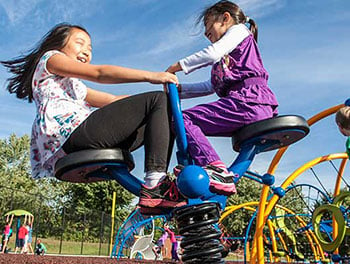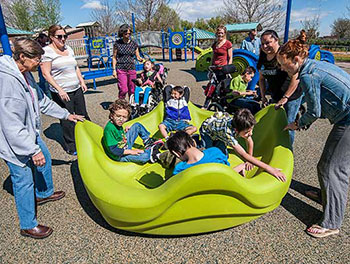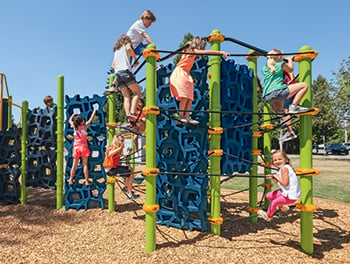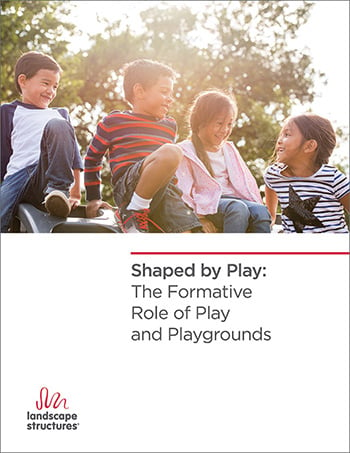The Importance of Playgrounds in Schools

Today's schools are not only tasked with preparing children for their future careers, but also teaching essential life skills, habits and attitudes that will help them successfully navigate adulthood. To do this and provide the best learning experience for students requires both indoor instruction and outdoor physical activity.
 While kids explore school playgrounds they are building important life skills that will eventually help children become effective thinkers, leaders and collaborators. Unfortunately, play is under scrutiny as school administrators, teachers and parents feel pressure for children to "perform" academically and spend more time in classroom instruction. And with the prevalence of electronics and the amount of screen time children are receiving each day, recess and free play on a playground are more important than ever.
While kids explore school playgrounds they are building important life skills that will eventually help children become effective thinkers, leaders and collaborators. Unfortunately, play is under scrutiny as school administrators, teachers and parents feel pressure for children to "perform" academically and spend more time in classroom instruction. And with the prevalence of electronics and the amount of screen time children are receiving each day, recess and free play on a playground are more important than ever.
By creating an environment where children can experience unstructured play, you're not only supporting their physical health but also increasing their chances to succeed in the classroom. Kids pay more attention to academic tasks when they are given frequent, brief opportunities for free play. Recess can also have a calming effect helping with disciplinary issues and impulse control.
Unstructured physical activity on the playground helps kids become smarter, healthier and stronger.
Importance of Play at School
It might look like just play, but when kids are active and running around a playground they are building critical developmental skills. Playgrounds provide the opportunity for children to practice skills that will ultimately play a role in adult competencies such as the ability to collaborate with others, develop decision making skills, and successfully take on leadership roles, persevere in the face of distractions, and generate creative ideas.
 Cognitive: According to Marie Hartwell-Walker, Ed.D. in an article about the benefits of play, 75 percent of the brain develops after a baby is born in the years between birth and early 20s and play is needed for healthy brain development. Play stimulates the brain connections between nerve cells helping a child develop both gross motor skills like walking, running, jumping and coordination along with fine motor skills like writing, manipulating small tools and detailed hand work. Play during the teen years and into adulthood helps the brain develop even more connectivity especially in the frontal lobe, which is the center for planning and making good decisions.
Cognitive: According to Marie Hartwell-Walker, Ed.D. in an article about the benefits of play, 75 percent of the brain develops after a baby is born in the years between birth and early 20s and play is needed for healthy brain development. Play stimulates the brain connections between nerve cells helping a child develop both gross motor skills like walking, running, jumping and coordination along with fine motor skills like writing, manipulating small tools and detailed hand work. Play during the teen years and into adulthood helps the brain develop even more connectivity especially in the frontal lobe, which is the center for planning and making good decisions.
Social and Emotional: In our whitepaper, Shaped by Play: How Play Types Impact Development, we observed playground interactions and how certain playground equipment facilitated different types of play. The interactions observed took many different forms.  Sometimes children engaged in group games like tag or simply talked to one another as they played like swinging side-by-side. Other times, they participated in collaborative activities like pushing one another on the swings or working together to rotate the OmniSpin® Spinner. There were also several instances of older children helping younger ones navigate the equipment, both physically (e.g., lifting them onto the OmniSpin Spinner) and psychologically (e.g., reassuring them that they didn’t need to be scared).
Sometimes children engaged in group games like tag or simply talked to one another as they played like swinging side-by-side. Other times, they participated in collaborative activities like pushing one another on the swings or working together to rotate the OmniSpin® Spinner. There were also several instances of older children helping younger ones navigate the equipment, both physically (e.g., lifting them onto the OmniSpin Spinner) and psychologically (e.g., reassuring them that they didn’t need to be scared).
As children play, they are learning persistence, patience, how to cope with frustration, to share with others, practice empathy and express their thoughts and ideas. These are all critical life skills that will help a child with his or her social interactions in school, within a wider community, among friends and eventually in the workplace and adult relationships.
 Physical: Playgrounds and exercise go hand in hand. Outdoor physical activity stimulates heart-healthy cardiovascular fitness while also offering opportunities to increase muscle strength, agility, balance, motor skills and even the ability to strategize. For example, playground equipment like monkey bars or climbing walls enhances upper body strength while targeting skills such as grip strength, hand-eye coordination and visual perception. Increased outdoor physical activity at school can also help reduce the childhood obesity epidemic and create healthy habits for exercise that will continue at home.
Physical: Playgrounds and exercise go hand in hand. Outdoor physical activity stimulates heart-healthy cardiovascular fitness while also offering opportunities to increase muscle strength, agility, balance, motor skills and even the ability to strategize. For example, playground equipment like monkey bars or climbing walls enhances upper body strength while targeting skills such as grip strength, hand-eye coordination and visual perception. Increased outdoor physical activity at school can also help reduce the childhood obesity epidemic and create healthy habits for exercise that will continue at home.
According to Play in Natural Environments: A pilot study quantifying the behavior of children on playground equipment (2017), a well-designed, sensory-rich playground, supports children's development across multiple domains and can elicit positive behaviors for children of all abilities. To start planning your school playground project and increase the developmental impact of play, contact a Landscape Structures consultant.
Physical Activity and Children’s Ability to Learn
Exercise is good for our body and our brain and science is helping back up what we intuitively know is true. Dr. John Ratey, author and Associate Clinical Professor of Psychiatry at Harvard Medical School, studies the connection between the brain and fitness, and says physical activity in school readies the brain for learning.
Dr. Ratey says physical activity in school found on a playground:
- Improves attention, decreases stress and anxiety, and prepares students to learn. It also improves motivation—helping kids try things they might not normally be inclined to try.
- Primes the brain cells to change when new information is introduced.
- Promotes the growth of new brain cells so the brain can absorb and retain new information.
Physical movement stimulates brain activity by improving blood flow to the brain. For an active child, this brings water, oxygen and glucose to the brain at a higher rate than it does to the brain of the sedentary child. When a brain receives the necessary nutrients, the child has a better ability to learn, respond and retain information.
Recess Holds the Key
Kids need physical activity to be healthy, strong and smart, and they can stay active if schools provide time for outdoor play. Getting kids active is important but how they are active matters as well. A research study from Pellegrini and Holmes referenced in the article, The cognitive benefits of play: Effects on the learning brain, says that physical education classes don't deliver the same benefits as recess. Researchers suspect that's because PE classes are too structured and rely too much on adult-imposed rules. To reap all the benefits of play, physical activity must be truly playful and an unstructured break in which kids are free to play without direction from adults.
 Several studies highlighted in our whitepaper, Shaped by Play: The Formative Role of Play and Playgrounds, show that children's activity during school recess contributes significantly to overall physical activity levels. Across a number of studies, elementary school children in particular spent 15 to 56 percent of their recess time engaging in moderate-to-vigorous physical activity. Outdoor unstructured play is uniquely motivating because some children may find it more enjoyable to chase one another in a game of "hot lava monster" than to play on a soccer team or run relay races during a PE class. Therefore, the time spent on a playground during recess may play a key role in helping children increase their physical activity.
Several studies highlighted in our whitepaper, Shaped by Play: The Formative Role of Play and Playgrounds, show that children's activity during school recess contributes significantly to overall physical activity levels. Across a number of studies, elementary school children in particular spent 15 to 56 percent of their recess time engaging in moderate-to-vigorous physical activity. Outdoor unstructured play is uniquely motivating because some children may find it more enjoyable to chase one another in a game of "hot lava monster" than to play on a soccer team or run relay races during a PE class. Therefore, the time spent on a playground during recess may play a key role in helping children increase their physical activity.
For more information about the benefits of recess and to learn about the resources available to improve the number of opportunities for outdoor physical activity, download our whitepaper, The Importance of Outdoor Play and Physical Activity During School Hours.